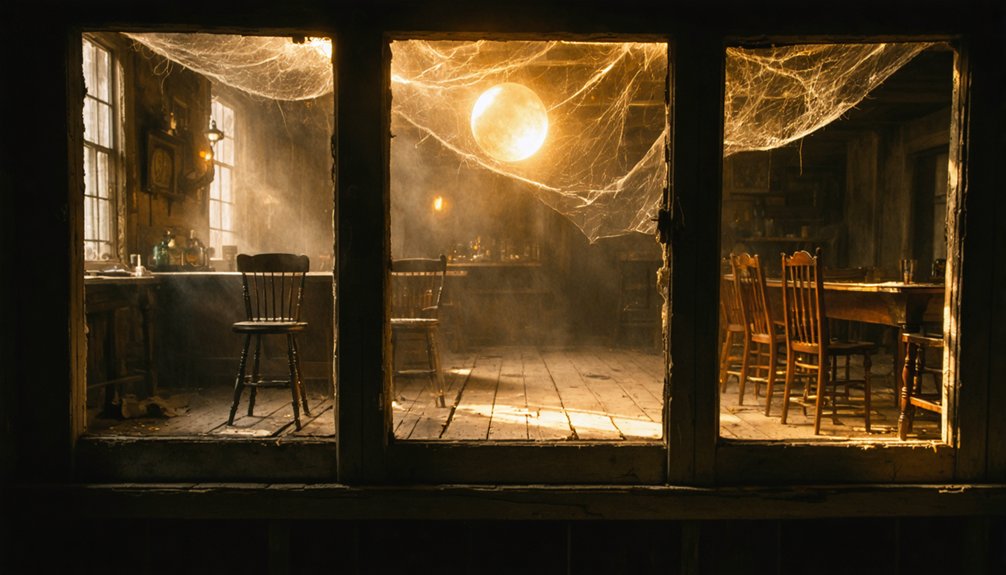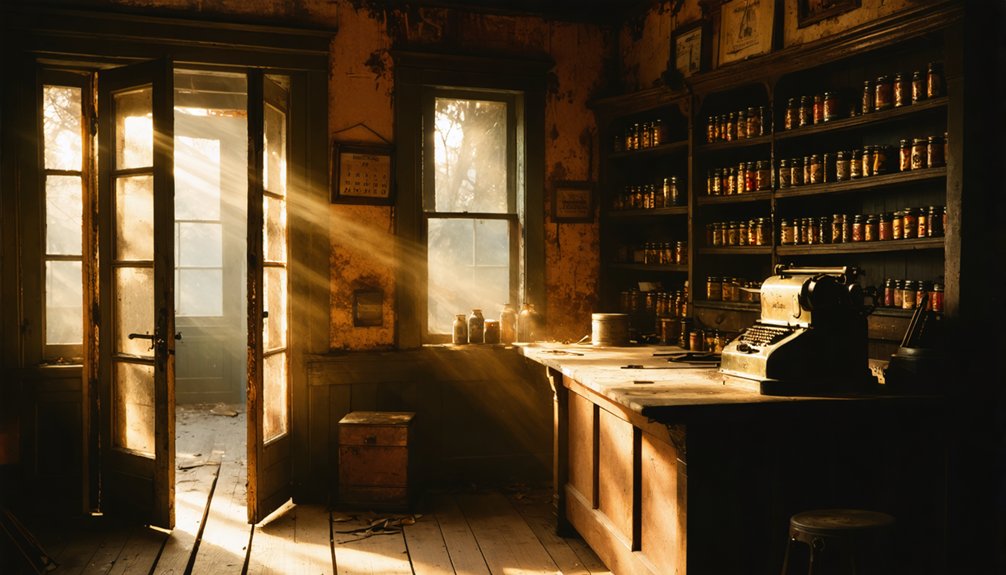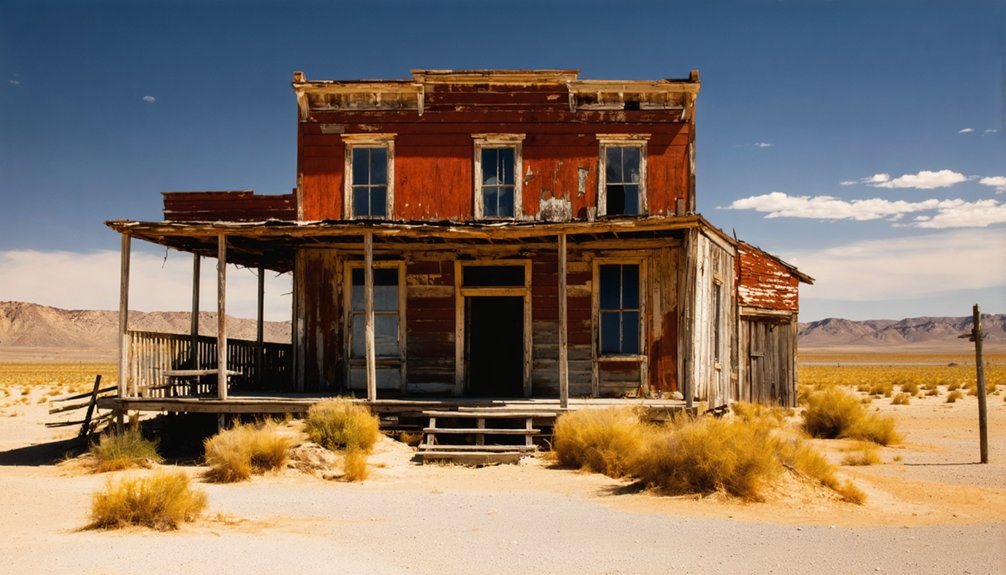Eastwood is a ghost town located one mile northwest of Julian, California, established in 1870 by Joseph Stancliff as a rival mining settlement. Unlike other ghost towns, you’ll find no remaining structures—just Eastwood Creek and Eastwood Hill at 4,160 feet elevation. The town failed due to disappointing mineral deposits and water scarcity, while Julian thrived. Local folklore includes ghostly encounters with “Little Joey,” who reportedly haunts the creek banks at twilight. The full story reveals California’s forgotten boom-town dreams.
Key Takeaways
- Eastwood was established in 1870 by Joseph Stancliff as a rival mining town to Julian, California.
- The ghost town is located one mile northwest of Julian at 33°05′15″N 116°36′40″W, at an elevation of 4,160 feet.
- Unlike many ghost towns, Eastwood lacks physical structures, with only Eastwood Creek and Eastwood Hill marking its existence.
- Eastwood failed to develop due to disappointing mineral deposits, water scarcity, and competition from nearby Julian.
- Local folklore includes stories about “Little Joey,” a ghostly child said to haunt the area with a lantern at dusk.
The Failed Town That Never Was
Though many ghost towns across California boast stories of boom and bust, Eastwood stands apart as a settlement that never truly began.
California’s ghosts tell tales of glory and decline, but Eastwood whispers only of dreams that never materialized.
You’ll find no crumbling buildings or abandoned mines here—just Eastwood Creek and Eastwood Hill preserving a name without substance.
In 1870, Joseph Stancliff’s speculative planning envisioned a rival to nearby Julian, positioning his dream town about a mile northwest of the established settlement.
But Eastwood couldn’t compete economically or attract sufficient investment. No infrastructure materialized, and the ambitious vision faded quickly. Unlike Clint Eastwood who successfully preserved the semi-rural character of Mission Ranch in Carmel, this town’s namesake had no millionaire savior. The failed California settlement shares nothing but a name with Eastwood, Nottinghamshire, the English town famous as D.H. Lawrence’s birthplace.
The town’s historical significance lies in what it represents: the risks of 19th-century town speculation in post-Gold Rush California.
Unlike Bodie or Whiskey Flats that thrived before declining, Eastwood exemplifies a rarer phenomenon—complete failure to launch.
Location and Geographic Features
Eastwood’s precise location sits at 33°05′15″N 116°36′40″W, positioned exactly one mile northwest of Julian in San Diego County’s historic mining district.
You’ll find this ghost town nestled at 1,270 meters (4,160 feet) elevation, surrounded by the rugged terrain characteristic of the Peninsular Ranges.
A topographic analysis reveals Eastwood Hill dominating the northern landscape, offering sweeping panoramic views of the Cleveland National Forest and Cuyamaca Mountains.
Eastwood Creek, a tributary named after the town, flows nearby and has become entwined with local folklore and hiking opportunities.
The ghost town’s regional significance stems from its position within the Mediterranean climate zone of Southern California’s mining country.
When exploring this remote area, you’ll appreciate the unspoiled wilderness that’s reclaimed what was once a bustling settlement.
Joseph Stancliff’s Ambitious Vision
You’ll find that Joseph Stancliff’s 1870 vision for Eastwood hinged entirely on creating a direct competitor to the already established Julian settlement.
He meticulously planned streets, plots, and essential structures on paper while naming local geographical features like Eastwood Creek and Eastwood Hill to cement the town’s presence.
Stancliff’s dream ultimately collapsed due to Julian’s stronger appeal, limited economic opportunities, and insufficient infrastructure investment, leaving behind only place names rather than an actual community.
Failed Rival to Julian
Despite its ambitious conception, Eastwood stands as one of California’s least-known ghost towns, existing primarily as a failed vision rather than an actual settlement.
You’ll find no ruins marking this town’s failed ambitions—just Eastwood Creek and a hill bearing its name at coordinates 33°05′15″N 116°36′40″W.
Joseph Stancliff strategically positioned his planned community one mile northwest of Julian at 4,160 feet elevation, hoping to divert settlers and commerce from the successful mining town.
But without significant mineral deposits, adequate water, or transportation infrastructure, Eastwood couldn’t attract the critical mass needed for survival. Unlike prosperous ghost town Calico, which once boasted a population of over 3,500 during its mining heyday, Eastwood never managed to establish a significant community. Similar to the case of Whiskey Flats, Eastwood represents part of California’s rich yet often overlooked frontier history.
Local lore adds intrigue through ghostly legends of “Little Joey,” said to haunt Eastwood Creek—perhaps the only “resident” this town ever truly claimed.
Stancliff’s Unrealized Dream
Joseph Stancliff envisioned far more than just a settlement when he meticulously drafted plans for Eastwood in the late 19th century. His blueprint detailed a thriving community anchored by robust mining operations and extensive infrastructure.
The settlement dynamics he imagined would transform this remote location into a regional powerhouse competing with established towns nearby. Like the historical accounts of winter of entrapment documented by Joseph A. King, Stancliff’s vision faced harsh environmental realities that would eventually overcome his ambitious plans. Similar to how Alvin H. Marill documented changes in television production landscapes, Stancliff’s plans reflected shifting economic priorities of the era.
- Extensive infrastructure including schools, lodgings, and commercial buildings to attract settlers
- Strategic town layout maximizing accessibility for businesses and residents
- Mining aspirations centered on presumed rich deposits of gold and silver
- Ancillary businesses supporting both mining operations and community needs
Despite his ambitious vision, Stancliff’s dream collapsed when geological surveys revealed disappointing mineral yields.
Without the economic foundation of mining wealth, insufficient investment followed, and harsh environmental conditions further challenged the settlement’s viability.
Eastwood’s abandonment symbolizes the precarious nature of frontier development.
Competition With Julian in the 1870S
When gold was discovered in the Cuyamaca Mountains in early 1870, Eastwood and Julian emerged almost simultaneously as mining camps, setting the stage for an inevitable competition.
While Julian quickly established itself with a formal mining district on February 15, 1870, Eastwood struggled to gain the same momentum among rival settlements.
Settlement patterns favored Julian from the start. The town attracted miners with significant gold finds and quickly developed permanent structures—sawmills, schools, and businesses. This development was spurred by the homesteading efforts of four cousins who established claims in the area.
Meanwhile, Eastwood remained smaller and less developed. Mining disputes further hampered Eastwood’s growth, particularly when the Rancho Cuyamaca land grant owners attempted to collect royalties.
Julian’s mines were deemed outside this jurisdiction in an 1873 court ruling, giving it a vital legal advantage that Eastwood lacked.
The discovery by Fred Coleman in 1869 had already established Julian as a promising location before Eastwood could gain significant traction.
The Legend of “Little Joey” and His Lantern

A persistent legend haunts the remnants of Eastwood, centered around a spectral child known as “Little Joey.” This ghostly figure, said to appear at dusk carrying a distinctive lantern, has become an integral part of local folklore despite lacking documentation in official historical records.
The ghostly child Joey wanders Eastwood at dusk, lantern in hand, undocumented yet unforgotten.
When you’re hiking near Eastwood Creek, you might experience one of the area’s most famous ghostly encounters. The legend serves as both mystery and warning:
- Joey’s mocking laughter echoes when hikers become lost
- His lantern symbolism represents guidance he never provides
- Sightings occur primarily along the creek banks at twilight
- The tale persists through oral tradition among visitors and locals
Some locals claim the ghost story gained popularity after Clint Eastwood’s film brought temporary attention to the area, mixing Hollywood fiction with local lore.
Due to “Eastwood” referring to multiple places and entities, researchers seeking historical verification should note that information about Joey may be found under various disambiguation pages rather than a single definitive source.
What Remains Today: Creek and Hill
Despite the passage of time erasing most traces of human settlement, Eastwood Creek and Eastwood Hill endure as the most tangible remnants of this forgotten California town.
You’ll find these geographic landmarks about a mile northwest of Julian, where the creek’s seasonal waters sustain a modest riparian ecosystem beneath the 4,160-foot elevation of its namesake hill.
No buildings remain at the former townsite—just the natural landscape reclaiming what was briefly disturbed.
The creek ecology provides a quiet sanctuary for native wildlife, while hilltop views reward hikers with panoramic vistas of San Diego’s mountainous backcountry.
Though unmarked by official signage, these features preserve Eastwood’s memory through their very names, silently telling stories that buildings no longer can.
Why Eastwood Failed While Julian Thrived

If you visit the Julian area today, you’ll notice Eastwood’s location near Eastwood Creek offered none of the geographic advantages that Julian enjoyed with its more favorable terrain and better access to water resources.
While Julian struck gold literally and figuratively during the late 19th century rush, Eastwood failed to discover comparable mineral wealth that could have attracted miners and established economic foundations.
Julian’s strategic position allowed it to diversify beyond mining into commerce and agriculture, whereas Eastwood’s disadvantageous location left Stancliff’s ambitious rival town plans permanently unrealized.
Geographic Challenges
While both mining settlements occupied similar elevations in California’s mountainous terrain, Eastwood faced geographic challenges that ultimately sealed its fate compared to its thriving neighbor Julian.
The rugged terrain barriers surrounding Eastwood created natural obstacles for expansion, transportation, and trade, while Julian benefited from more navigable foothills that connected to established routes.
- Eastwood’s location (4,160 feet) featured steeper hills and more difficult access than Julian’s relatively gentle mountain meadows.
- Water scarcity plagued Eastwood Creek, while Julian enjoyed reliable water sources vital for mining operations and settlement.
- Eastwood’s position a mile northwest of Julian isolated it from major trails, limiting essential trade and supply flows.
- Harsh weather and snow accumulation in Eastwood’s elevated hills made year-round habitation and infrastructure development nearly impossible.
Gold Rush Economics
The stark geographic challenges Eastwood faced represented only part of its downfall story. The economics of gold extraction ultimately sealed its fate, creating an unbridgeable gap between it and successful towns like Julian.
While Julian’s mines yielded steady gold over decades, Eastwood’s deposits exhausted quickly, lacking the sustainability needed for permanent settlement. Julian evolved from primitive mining techniques to sophisticated hard-rock operations, attracting capital investment that Eastwood never secured.
You’ll find that successful Gold Rush towns built diversified economies beyond mere mining—banks, merchants, and services that created lasting infrastructure. Eastwood never reached this critical mass.
Exploring the Ghost Town Site
Venturing into the historic site of Eastwood offers visitors a glimpse into California’s forgotten mining past, situated just one mile northwest of Julian at approximately 33°05′15″N 116°36′40″W.
You’ll discover a landscape shaped by 1870s placer mining operations along Eastwood Creek, where Joseph Stancliff’s vision of a thriving town never materialized.
When exploring this mining heritage site, remember:
- Access requires hiking through rugged mountain terrain at 4,160 feet elevation
- Few physical structures remain, focus instead on altered creek beds and mining terrain
- Local folklore mentions ghostly encounters with “Little Joey” appearing at dusk
- Navigation tools are essential as the remote location offers no amenities
The ghost town sits within the Cuyamaca Mountains ecosystem, with seasonal weather affecting trail conditions and creek flow.
Eastwood in Local History and Folklore

If you’re curious about Eastwood’s rivalry with Julian, you’ll find the town’s short-lived history began in 1870 when Joseph Stancliff ambitiously planned it as a competitor to the now-thriving Julian.
While the settlement failed to materialize beyond its initial plans, Eastwood’s most enduring legacy lives on through the haunting tale of Little Joey, a spectral figure said to appear at dusk near Eastwood Creek with a lantern, laughing as he lures lost hikers deeper into the wilderness.
The ghostly legend of Little Joey exemplifies how failed frontier towns often leave behind supernatural folklore rather than physical structures, creating cultural touchstones that outlast the settlements themselves.
Competing With Julian
While Julian thrived as a gold rush settlement after A.E. “Fred” Coleman’s 1869 discovery, Joseph Stancliff established Eastwood in 1870 specifically to challenge Julian’s growing prominence.
Eastwood’s legacy became one of ambitious failure against Julian’s triumph. Located just a mile northwest along Eastwood Creek, the planned rival town never materialized beyond its initial conception.
- Julian secured its future through successful mining claims and legal victories that Eastwood couldn’t match.
- While Eastwood faded, Julian pivoted successfully from mining to apple cultivation, using its volcanic soil and altitude.
- Julian’s strong community bonds fostered permanence, unlike Eastwood’s speculative foundations.
- Economic diversification into agriculture and tourism guaranteed Julian’s survival while Eastwood became merely a geographical footnote.
Little Joey’s Legend
Among Eastwood’s enduring contributions to California’s ghostly folklore stands the enigmatic figure of Little Joey, a character whose spectral presence continues to haunt both the imagination and geography of this failed boomtown rival to Julian.
When you visit, locals might warn you about Little Joey’s Ghost, said to guard hidden gold veins and abandoned mines. This solitary miner—or hunter or gunman, depending on who’s telling the story—embodies the rugged individualism that defined the region’s mining era.
Eastwood Folklore portrays him as both protector and harbinger, appearing to warn trespassers or guide worthy seekers. Despite lacking historical documentation, Little Joey’s legend serves economic purposes too—driving tourism and preserving community heritage through ghost tours and storytelling events.
He represents Eastwood’s soul: ambitious, mysterious, and ultimately untamed.
Preserving the Memory of Lost California Towns
California’s forgotten settlements, like Eastwood, endure through a blend of historical documentation and local folklore rather than brick and stone.
Phantom places linger in California’s memory, preserved not in ruins but through stories passed down across generations.
When you explore San Diego County, you’re encountering a landscape where historical preservation happens through both official records and community engagement. The memory of places like Eastwood persists in multiple forms:
- Geographic anchors—Eastwood Creek and Hill embed the town’s legacy into the physical landscape
- Digital archiving projects that capture old photographs, land deeds, and oral histories
- Educational initiatives through local schools and museums showcasing ghost town exhibits
- Community-driven storytelling events that keep the folklore alive, including Little Joey’s ghostly presence
These preservation methods guarantee California’s abandoned dreams don’t vanish completely from our collective memory.
Frequently Asked Questions
Is Eastwood Accessible to the Public for Ghost Town Tourism?
You’re out of luck. Eastwood isn’t accessible for ghost town tourism—no facilities, guided tours, or preserved structures exist. It’s merely geographic markers where a failed settlement once stood.
What Happened to Joseph Stancliff After Eastwood’s Failure?
You won’t find concrete records of Stancliff’s fate after Eastwood failed. His legacy remains only in toponyms, while Eastwood’s economic impact dissolved completely. Historical documents don’t track his subsequent activities or ventures.
Were There Any Businesses or Structures Ever Built in Eastwood?
No, you won’t find any Eastwood architecture or businesses. Historical records confirm the town never progressed beyond planning. Eastwood’s history exists only in name—the creek and hill remain its sole legacy.
Have Paranormal Investigators Documented Activity at the Site?
Unlike Bodie, you won’t find documented ghost sightings at Eastwood. No paranormal investigators have published evidence of activity at this site, though Eastwood House has unverified reports nearby.
Are There Hiking Trails That Specifically Visit Eastwood’s Location?
There aren’t dedicated trails to Eastwood. You’ll need to navigate from the French Springs Trailhead using a high-clearance vehicle and then hike offshoot paths, creating your own rugged nature exploration and hiking experience.
References
- https://kids.kiddle.co/Eastwood
- https://www.wikiwand.com/en/articles/Eastwood
- https://californialocal.com/localnews/statewide/ca/article/show/51711-10-california-ghost-towns-to-see/
- https://adventure.com/ghost-town-emerges-from-shrinking/
- https://www.sfgate.com/centralcoast/article/lake-isabella-ghost-town-emerges-17415393.php
- https://www.youtube.com/watch?v=wfJdWdBvY5U
- https://en.wikipedia.org/wiki/List_of_ghost_towns_in_California
- https://giggster.com/guide/movie-location/where-was-pale-rider-filmed
- https://www.latimes.com/archives/la-xpm-1986-12-19-mn-3533-story.html
- https://www.youtube.com/watch?v=OD9M6MP6RRU



